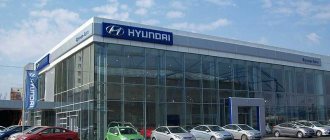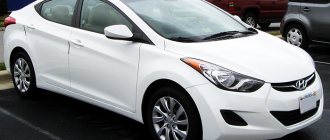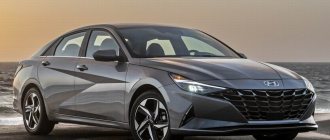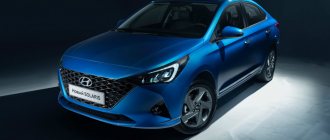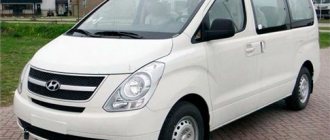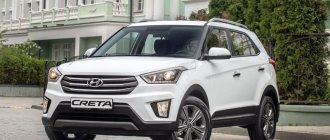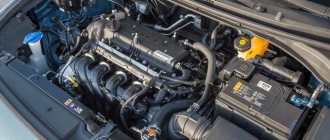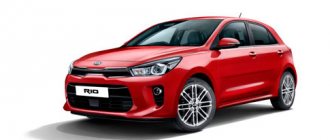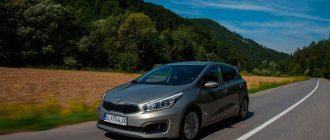The Hyundai ix35 replaced the popular Tucson in 2010. The crossover is built on the same platform as the third generation Kia Sportage. The ix35 was assembled in South Korea, as well as in Europe - at the Kia factories in Slovakia and Hyundai in the Czech Republic.
Engines
On the Russian market, the Hyundai ix 35 was offered with 2-liter engines: gasoline (150 hp) and diesel (136 and 184 hp). All power units have a timing chain drive.
Some owners of gasoline IX 35 after 50-150 thousand km notice an extraneous knocking sound while the engine is running. The reasons were different: a faulty hydraulic chain tensioner, a CVVT clutch (variable valve timing), hydraulic compensators (installed after restyling in 2013) or even scuffs in the cylinders.
Fortunately, bullies are not an endemic phenomenon. When applying during the warranty period, dealers did not replace the entire engine, but only the “short block” complete with pistons and crankshaft. If the warranty is out, then the block will have to be sleeved - from 100,000 rubles.
Starting the engine may be difficult due to a malfunction of the clutch pedal switch (with a manual transmission) / brake pedal (with an automatic transmission), and in cold weather - due to a “retracting” starter (the lubricant thickens).
In diesel units, after 50-100 thousand km, sometimes the crankshaft damper pulley is rented out (from 7,000 rubles). And problems with starting a cold diesel engine arise due to poor contact or oxidation at the crimping point of the glow plug strip wiring (about 1,000 rubles). In addition, the glow plug relay (from 4,000 rubles) or the spark plugs themselves (1,500 rubles/piece) may fail.
Front box
For the ix 35 there are three gearboxes: 5 and 6-speed manual, as well as a 6-speed automatic. There are no serious problems with the boxes. In the case of manual transmission, many note the appearance of extraneous noise that disappears after depressing the clutch, and in the case of automatic transmission, owners complain about noticeable shocks during shifts.
Transmission
Poor protection of spline connections of drive elements from exposure to water and dirt leads to unpleasant consequences. So, after 50-100 thousand km, corrosion kills the spline joint of the right composite drive shaft. The splines are licked and a backlash and a hum appear. The intermediate shaft and inner CV joint have to be replaced: 7,000 rubles per element plus 3,000 rubles for labor.
Worse, the mounting of the intermediate shaft support bearing may break off. The mount is part of the block. Ideally, the block needs to be replaced, but argon welding can get rid of it. Fortunately, this problem is much less common.
Another example of poor protection of spline joints is corrosion and cutting of the drive shaft splines in the transfer case and differential cup (after 100-150 thousand km). The repair will be very expensive - about 80,000 rubles. Owners of diesel cars are primarily at risk. Prevention of spline joints will help to avoid problems - lubrication every 30-40 thousand km. In addition, the high torque of diesel engines can lead to the destruction of the differential basket along the weld seam.
The Hyundai ix 35 used two all-wheel drive couplings. Until 2011, an electromagnetic clutch of Japanese origin JTEKT was installed, and since 2011, a hydraulic clutch from the Austrian manufacturer Magna Steyr was installed.
Mitsubishi ASX Club
The coupling is quite reliable. Malfunctions occur due to damage to the wiring (3,000 rubles) or wear of the electric motor brushes (at high mileage). After 100,000 km, the clutch seal sometimes begins to leak.
The outboard bearing of the propeller shaft (4-5 thousand rubles) can hum after 80-140 thousand km.
Chassis
Knocking suspension is the reason for many complaints about Hyundai, and not only the ix35. Knocks when driving over uneven surfaces worsen with the arrival of cold weather. There are several sources of extraneous sounds. The main thing is the original shock absorber struts, which can begin to knock after 2-3 thousand km. Official services replaced the racks under warranty. But that didn't mean they wouldn't knock again. After all, the new shock absorbers are the same. Some managed to change them three times in 20,000 km. But the problem is not total; there are also those who have driven up to 80-100 thousand km without ever noticing that there is something knocking in the suspension.
Another source of knocking is the boot and bumper of the shock absorber strut flying off the seat. The manufacturer recommended fixing the boot on the stand using sealant. The popular method is to wrap electrical tape around the rod or tie the “buffer” (bump stop) with clamps. On the ix35 2012 model year, the manufacturer eliminated this design flaw.
After 50,000 km, the steering rack may knock. Wheel bearings (from 1,000 rubles) last more than 60-100 thousand km.
Silent blocks and ball bearings of levers serve more than 100-150 thousand km. But the rear arm bracket, to which the stabilizer bar is attached, can collapse after 60-100 thousand km. The bracket can be welded. The new lever is available for 9,000 rubles. The defect affects exclusively all-wheel drive versions of the Hyundai IX 35.
Body and interior
The paintwork is traditionally soft, scratches easily, and becomes chipped over time. Unfortunately, after 3-6 years, paint blistering can sometimes be found on the rear wheel arches, tailgate, hood, roof and windshield pillars. Dealers are reluctant to recognize this problem as a warranty issue.
The interior of the IX 35 often begins to creak, especially in winter - before the interior warms up. Most often, the source of extraneous sounds is the armrest between the front seats.
Another unpleasant moment is the crumbling filling of the driver's seat cushion. Due to close friction with the sharp edges of the frame, the “inside” can crumble completely in just 30,000 km. What is surprising is the persistence with which the manufacturer changed the seat cushion over and over again until the warranty expired. Only in 2015 was it decided to install a special lining on the frame that resists destructive friction.
It’s the same story with the peeling leather covering of the steering wheel and door trim, at the point of contact with the driver’s elbow. The “leather” of the chairs is also not durable. Wrinkles appear on the driver's seat, the leather cracks and tears.
Sometimes the heater motor starts making noise (it needs to be disassembled, cleaned and lubricated), or the plastic air duct casing under the passenger seat flies out of its place. There are also failures of parking sensors, rear view cameras and “glitches” of the standard radio. There have also been cases of spontaneous ignition of control lamps followed by a short-term extinguishing of the instrument panel. In such cases, dealers changed the “tidy”.
Conclusion
When choosing a used Hyundai ix35, special attention should be paid to the operation of the all-wheel drive system. Other defects can be easily eliminated.
Engine and fuel consumption
Most often, these cars are equipped with two-liter Hyundai AX35, which is unpretentious to the quality of gasoline and works equally well on AI-92 and AI-95 fuel, but it is better to fill it with gasoline with a higher octane number. In the city, the engine power is more than enough, but with a load the car becomes sharply dull, and the dynamics are greatly reduced. This also applies to driving on the highway.
Fuel consumption in quiet city driving mode is 10 liters, which is an excellent indicator considering the dimensions of the car and the fairly powerful two-liter engine. In winter, fuel consumption in the city increases to 13 liters. On the highway, the car consumes 8 liters per hundred when driving at a speed of 90 km/h.
According to reviews, the Hyundai AX35 diesel does not have the same problems that a gasoline engine has. When using diesel fuel, the car consumes less fuel, is more dynamic, and when the trunk is loaded, even if it loses dynamics, it is not as significant as in the case of a gasoline engine.
Separately, it is worth mentioning winter operation. Even at very low temperatures, the car starts with a half turn of the starter. But at the same time the engine makes unnatural noise. Most drivers did not believe that the car used a gasoline engine; they believed that there was a diesel engine inside. Be that as it may, there are no problems with the engine, even in winter. So, according to reviews from car owners, the Hyundai AX35 is an excellent car for Russia, where high negative temperatures in winter are the norm.
Hyundai ix35 › Options and prices
In Russia, the price of the Hyundai ix35 2021 in a new body is 1,199,900 - 1,668,900 rubles, the car is presented for sale in 9 trim levels. New configurations and prices were provided by the official Hyundai website. To date, this model is not supplied to Russia.
Official dealers and car showrooms where you can buy Hyundai ix35: Moscow.
| Equipment * | Engine | Box | Drive unit | Overclocking | Speed | Consumption | Price** |
| Start | gasoline 2.0 l. | 150 hp | M.T. | Front | 10.7 | 185 km/h | 11.4 | 6.9 | 8.6 | RUB 1,199,900 |
| gasoline 2.0 l. | 150 hp | AT | Front | 11.5 | 177 km/h | 11.7 | 7.0 | 8.8 | RUB 1,259,900 | |
| gasoline 2.0 l. | 150 hp | AT | 4x4 Full | 11.7 | 175 km/h | 11.7 | 7.0 | 8.8 | RUB 1,339,900 | |
| Start + Advanced | gasoline 2.0 l. | 150 hp | AT | Front | 11.5 | 177 km/h | 11.7 | 7.0 | 8.8 | RUB 1,318,900 |
| Comfort | gasoline 2.0 l. | 150 hp | M.T. | Front | 10.7 | 185 km/h | 11.4 | 6.9 | 8.6 | RUB 1,318,900 |
| gasoline 2.0 l. | 150 hp | AT | Front | 11.5 | 177 km/h | 11.7 | 7.0 | 8.8 | RUB 1,368,900 | |
| gasoline 2.0 l. | 150 hp | M.T. | 4x4 Full | 11.3 | 184 km/h | 11.4 | 6.9 | 8.6 | RUB 1,388,900 | |
| gasoline 2.0 l. | 150 hp | AT | 4x4 Full | 11.7 | 175 km/h | 11.7 | 7.0 | 8.8 | RUB 1,438,900 | |
| diesel 2.0 l. | 136 hp | AT | 4x4 Full | 12.1 | 182 km/h | 8.6 | 5.8 | 6.8 | RUB 1,508,900 | |
| Start Limited Edition | gasoline 2.0 l. | 150 hp | AT | Front | 11.5 | 177 km/h | 11.7 | 7.0 | 8.8 | RUB 1,329,900 |
| Style Edition | gasoline 2.0 l. | 150 hp | AT | Front | 11.5 | 177 km/h | 11.7 | 7.0 | 8.8 | RUB 1,418,900 |
| gasoline 2.0 l. | 150 hp | AT | 4x4 Full | 11.7 | 175 km/h | 11.7 | 7.0 | 8.8 | RUB 1,488,900 | |
| diesel 2.0 l. | 184 hp | AT | 4x4 Full | 9.8 | 195 km/h | 9.2 | 6.0 | 7.2 | RUB 1,609,900 | |
| Travel | gasoline 2.0 l. | 150 hp | AT | Front | 11.5 | 177 km/h | 11.7 | 7.0 | 8.8 | RUB 1,458,900 |
| gasoline 2.0 l. |
In which countries and where is Hyundai Santa Fe assembled, factories in Russia
It is not always clear where the car is assembled, because the last update of the model was seven years ago (in 2010). By the way, from that moment on, no significant changes were made - only the appearance was adjusted.
For some period, Elantra was assembled for the Russian Federation and Europe in the Czech Republic (in the city of Nosovica).
The car was also produced in St. Petersburg. In 2009, assembly of the “South Korean” was established in Ukraine, at the Bogdan plant. At the same time, the main supplier still remains South Korea (Ulsan).
It is from there that the car is sent to many countries, including Russia. By the way, in the period from 2000-2007, Elantra was produced in Taganrog (“Tagaz”).
In addition to those already listed above, Elantra factories are located in Turkey, the Czech Republic, China, Brazil and India. But the main supplier for Russia (with rare exceptions) is South Korea.
Why did they stop producing the Hyundai ix35?
| 150 hp
AT4×4 Full11.7175 km/h11.7 | 7.0 | RUR 8.81 528 900 diesel 2.0 l. | 184 hp AT4×4 Full9.8195 km/h9.2 | 6.0 | 7.21 678 900 RUR Travel Limited Edition petrol 2.0 l. | 150 hpATFront11.5177 km/h11.7 | 7.0 | 8.81 498 900 rub. petrol 2.0 l. | 150 hp AT4×4 Full 11.7175 km/h 11.7 | 7.0 | 8.81 568 900 RUR Prime petrol 2.0 l. | 150 hp AT4×4 Full 11.7175 km/h 11.7 | 7.0 | 8.81 628 900 RUR Prime + Style petrol 2.0 l. | 150 hp AT4×4 Full 11.7175 km/h 11.7 | 7.0 | 8.81 668 900 RUR Start ***gasoline 2.0 l. | 150 hpMTFront10.7185 km/h11.4 | 6.9 | 8.6from 1,019,900 rub.* — The table shows: Engine with volume (liters) and power (horsepower). Transmission: MT - manual (manual), AT - automatic, AMT - automatic (robot), CVT - variator. Acceleration from 0 to 100 km/h in seconds. Maximum vehicle speed. Fuel consumption in liters per 100 km: in the city | on the track | in a mixed cycle. ** — Manufacturer’s recommended maximum resale price for a new car at an official dealer, excluding discounts and promotions (as of March 15, 2016). *** — This package is for promotional purposes only.
Hyundai ix35 › Equipment
Select a package to view the basic and additional equipment that is included in it.
The section is currently being updated.
Hyundai ix35 - SUV crossover from the South Korean company Hyundai Motor Company" was born in 2009, replacing its predecessor Hyundai Tucson (by the way, in Korea this name was retained for it, only two letters were added to it: Hyundai Tucson ix) . The acquaintance with him took place at the automobile exhibition in Frankfurt in September. Since then, the Hyundai ix35 has been produced not only in Korea, but also in Slovakia and China.
Off-road test drive of the Hyundai ix35 crossover (video)
In this video you will learn how the Hyundai ix35 behaves off-road.
Hyundai ix35. Owner reviews
Hyundai ix35 is a fairly popular model among crossovers, so it’s not difficult to find a large number of reviews about this car
Due to the popularity of the crossover on the Internet, it is easy to find a large number of reviews and ratings from drivers about the Hyundai ix35. It is from these sources that one should judge the pros and cons of a vehicle.
The overall rating of drivers is 4 on a five-point scale. For the most part, the comments about this crossover are similar.
Therefore, it is easy to draw the appropriate conclusions:
- The driver's seat is not comfortable enough. The cushion is not very adjustable, and the backrest has to be lowered far back, making it uncomfortable for the rear passenger.
- Creak and knock. After six months of driving, the armrests and seats squeak loudly when adjusted. After six months to a year of operation, a knocking sound is heard due to instability of the gear selector, from the bushing on the electric power steering, or as a result of transmission problems.
- "Unrespectable design." Sharp curves and futuristic designs do not look representative enough for conservative people. The colors and shapes of individual parts are very annoying to some drivers.
- Cheap materials in the cabin. Instead of leather - dermantine. The plastic is not of good quality.
- High fuel consumption. 11-12 liters of fuel are consumed per trip.
- Minor breakdowns often occur. Shock absorbers have to be replaced especially quickly.
- Low ground clearance, which is why the car is not sufficiently adapted to domestic roads.
- Desire to change car. Every third owner of this crossover would like to exchange it for a German car.
- The engine does not produce full power.
- After a year of use, your computer may malfunction.
- Smooth ride. The crossover handles the road confidently and smoothly at speeds of 150-180 km/h.
Price
The cost depends on the configuration and engine of the car. In showrooms, the Hyundai IX 35 crossover will be sold at prices ranging from $26,000 to $37,300.
Bottom line
Hyundai ix35 is a car that showcases modern design and practicality. At first glance, it is easy to overestimate his abilities.
Driving around the city or on vacation will be comfortable, and many little things will pleasantly please drivers. But while enjoying driving, you should be prepared for minor unpleasant surprises.
Video review of Hyundai ix35
In the presented video you will see a detailed test drive of the Hyundai ix35, where the advantages and disadvantages of this car will be discussed.
The Hyundai car brand is one of the most popular and recognizable in our country; the company name is translated from South Korean as “modernity.” By the way, the correct pronunciation of the brand is not “Hyundai”, not “Hyundai”, not “Hyundai”, as many mistakenly pronounce, but “Hyundai”. Hyundai cars are assembled in several countries around the world and on all continents, from where they are delivered to various parts of the planet. The company's production volumes are also mesmerizing: 1.73 million cars were produced in Hyundai in 2010.
Hyundai models sold in Russia are assembled in different countries; Let's list the largest car factories where Hyundai cars are assembled for subsequent sale in Russia:
- The car plant in Ulsan, South Korea is the largest Hyundai plant, where they produce the largest number of cars of this brand, 2/3 of which are assembled for further export to other countries.
- The TAGAZ automobile plant in Taganrog assembled some models of Hyundai cars until 2010.
- In 2008, construction began on Hyundai's own car plant in Russia, Hyundai Motor Manufacturing Rus, which began producing the first car models in September 2010. This car plant still operates today, and the lion’s share of all Hyundai cars for Russia is assembled here, and production automation here reaches 80 percent. The automobile plant is located in the industrial district of Kamenka in St. Petersburg.
- The Hyundai car plant in Turkey is the first Hyundai car factory to open outside of South Korea, in 1998, and one of the company's most powerful car factories today.
- In addition to those listed, Hyundai cars are also assembled in Brazil, the USA, China, the Czech Republic and India, however, cars of this brand are not supplied to Russia from these countries.
Automobile plant in Ulsan (left) and St. Petersburg (right)
Where is Hyundai Solaris assembled?
One of the best-selling cars in Russia (Solaris is among the top five most popular models in our country almost every year), Hyundai Solaris in 2011 replaced the outdated Hyundai Accent (meanwhile, in all other countries except Russia and South Korea, the model still sold under its old brand). In Russia, the construction of an automobile plant in Kamenka in 2010 marked the launch of a new model - Hyundai Solaris is still assembled entirely in Russia. Here the production of Solaris body elements, their subsequent welding and painting takes place. Solaris' sister car is also assembled here.
Where is Hyundai ix35 assembled?
The most popular budget crossover among Russian car enthusiasts, the Hyundai ix35, as a replacement for the Tucson model, first saw the light in 2009, and began being delivered to Russia in 2010. The first generation of the car was assembled in as many as three countries, and from all three it was delivered to Russia. Thus, the first generation Hyundai ix35 can be found in Czech, Slovak or South Korean assembly. In addition, the car was also assembled in China for domestic markets. But the Russian assembly of the Hyundai ix35 has not yet been mastered, and even the current generation of the model is assembled in the Czech Republic.
Where is Hyundai i30 assembled?
First appearing in 2007 on the market, including the Russian one, the Hyundai i30 immediately won the hearts of many car enthusiasts. The car has already survived three generations of its assembly, and today the Hyundai i30 is assembled for the Russian market at the Czech automobile plant in the city of Nosovitz. However, until 2009, the Hyundai i30 was delivered to Russia, assembled in South Korea. The car produced there is still supplied to a number of other countries to this day, and, in addition, the model is assembled at the Hyundai plant in China.
Where is Hyundai Santa Fe assembled?
The legendary and famous crossover is a slightly more expensive alternative to the Hyundai Tucson/ix35, which quickly conquered the consumer market almost all over the world. Hyundai Santa Fe is today assembled in South Korea and the USA, and is supplied to Russia only from South Korea, the Ulsan plant. The first and second generations were also assembled in Taganrog at the TAGAZ automobile plant. Moreover, for a short time after 2009, the first generation of Hyundai Santa Fe could only be purchased from Taganrog assembly, since the original plant stopped assembling the first generation of the car in connection with the launch of the second generation.
Where is Hyundai i10 assembled?
A subcompact model of one of the largest automakers represented in Russia, the Hyundai i10 first saw the light, as well as its older brother - the Hyundai i30 - in 2007 and today is assembled in India and Turkey, and the latest generation i10 is delivered to Russia assembled only in Turkey. Meanwhile, until 2013, the car for Russia was assembled in India.
Where is Hyundai i40 assembled?
And here is the first “purebred” Korean of the Hyundai Corporation! The i40 model is a representative of the D-class, which first saw the light in 2011 as a station wagon and in 2012 as a sedan. The Hyundai i40 model is assembled at the company's largest plant, Ulsan, in South Korea.
Where is Hyundai i20 assembled?
Another “purebred” Korean - the Hyundai i20 - appeared on the Russian market in 2009 as a replacement for the outdated Hyundai Getz model and was then supplied from South Korea, India and Turkey, however, starting from its second generation, the model for Russia is assembled only in South Korea.
Where is Hyundai Elantra (Avante) assembled?
The Hyundai Elantra is an older model - it began production back in 1990, replacing the earlier model - Stellar. Today, in a number of other markets, the Elantra is sold under the Avante or Lantra brand. Hyundai Elantra is currently assembled at the company's original and largest automobile plant in Ulsan, South Korea. Moreover, almost all generations of the model were assembled there, with rare exceptions of cars produced for other countries, as well as generations of Elantra produced between 2000 and 2007, which were assembled in Russia at the TAGAZ plant in Taganrog.
Where is Hyundai Sonata (NF) assembled?
An even older Hyundai model than the Elantra, the Hyundai Sonata, also sold in some markets under the name Sonata NF or simply NF, is assembled in South Korea, and for the US consumer market is assembled directly at a car plant in North America. From 2003 to 2010, the Sonata (the most recognizable, however, its generation) was also assembled at the TAGAZ plant in Taganrog.
Where was the Hyundai Coupe (Genesis Coupe) assembled?
At one time, the favorite of young people and the now discontinued model Hyundai Coupe, starting in 2009, was replaced by a more advanced model - the Hyundai Genesis Coupe. The Hyundai Coupe was also known as the Tiburon, produced since 1996 and assembled in South Korea, Turkey and Thailand. For Russia, the Hyundai Coupe was assembled at the South Korean plant in Ulsan.
Where is Hyundai Genesis assembled?
A proud representative of the full-size E-class, the Hyundai Genesis is also a “purebred” Korean and is assembled at a car plant in the city of Ulsan. This is a relatively new Hyundai model, first released in 2008.
Where is Hyundai Equus assembled?
The largest, most expensive premium F class sedan, Hyundai Equus is the real pride of the company. Hyundai Equus has been produced since 1999, however, new cars of the model were not delivered to Russia at first, and Russians saw them only in 2009. Until 2013, Hyundai Equus for Russia was assembled in South Korea in Ulsan. Today, the assembly of the Hyundai Equus began at the Avtotor car plant in Kaliningrad, where it is assembled together with the Kia Quoris.
Where is the Hyundai ix35 assembled for the Russian market?
It has been sold in Russia since April 2010. In October 2013, an updated model of this car appeared on our market; the changes affected mainly its configurations. And we are updating the story about him.
The overall dimensions of this crossover are as follows: length - 4410 mm, width - 1820 mm, height - 1660 mm, wheelbase - 2640 mm. The ground clearance of the Hyundai ix35 is 170 mm, and the luggage compartment volume is a minimum of 591 liters and a maximum of 1436 liters. The total curb weight of the car is 1980-2140 kg.
The Hyundai ix35 is sold on the Russian market with both a two-liter gasoline engine producing 149.6 hp and two-liter turbodiesel engines producing 136 hp. and 184 hp Petrol versions can be front-wheel drive or all-wheel drive and are equipped with either a five-speed manual transmission or a six-speed automatic. Diesel Hyundai ix35s are available only with all-wheel drive, and are paired with a less powerful engine with either a six-speed manual transmission or an automatic transmission with the same number of steps, and on crossovers with a 184-horsepower engine there is only an automatic transmission.
Hyundai ix35, with a gasoline engine, is capable of reaching a maximum speed of about 176-181 km/h, and their diesel “brothers” are 194 km/h. The acceleration time from zero to 100 km/h for the first crossovers is within 10.4-11.3 seconds, and for the second - 10.2 seconds.
Diesel Hyundai ix35 are more economical, they consume fuel in the city 6.7/9.1 l/100 km (136 hp/184 hp), outside the city - 5.1/6.0 l/100 km, with a combined cycle - 5.7/7.1 l/100 km. For gasoline versions, similar figures range from 9.8-10.6 l/100 km, 6.1-6.8 l/100 km and 7.5-8.2 l/100 km. The volume of the fuel tank is 58 liters.
The Hyundai ix35 uses an independent, MacPherson-type spring suspension with anti-roll bar in the front and an independent, multi-link (2 transverse and 1 longitudinal), with anti-roll bar in the rear. Disc brakes with wear indicators are on all wheels; the front ones (mechanisms) are ventilated. The car may have wheels shod with tires of one of two sizes: 225/60 R17 or 225/55 R18.
Petrol Hyundai ix35s are offered in six different equipment options: Start, Comfort, Start+Advanced package, Travel, Prime and Prime+Style package. The first four modifications are available for front-wheel drive crossovers, and the second and last three are available for all-wheel drive crossovers. Diesel models are available in Comfort and Travel versions.
The basic Hyundai ix35 Start includes frontal airbags for the driver and front passenger (the passenger has a deactivation function), front seat belt pretensioners, anti-lock braking system (ABS), an immobilizer, a seat belt warning system, a warning system for rear drivers during emergency braking, central locking with remote control in a folding ignition key and alarm system, height-adjustable steering wheel, height-adjustable driver's seat, electric power steering, front and rear electric windows, exterior rear-view mirrors with electric adjustment and heating, front and rear armrests, trip computer, air conditioning.
In addition, the Hyundai ix35 Start has USB and AUX connectors, an audio system (RDS, radio, 6 speakers, CD/MP3, FM/AM) with steering wheel controls, a rear seat backrest that folds in a 60:40 ratio, a trunk curtain, hooks for cargo securing in the trunk, 12V socket in the trunk, fabric seat upholstery, LED front position lights, fog lights, light tinted windows, full-size spare tire on alloy wheel, rear spoiler with additional brake light, body-colored bumpers, alloy wheels 17″ with tires 225/60 R17.
The Hyundai ix35 Start+Advanced package adds side airbags, curtain airbags for front and rear passengers, reach-adjustable steering wheel, dual-zone climate control with an air ionization system, heated windshield wiper rest zone, leather-trimmed steering wheel and gear knob, painted in body color of the door handles and exterior mirror housings, and in the Hyundai ix35 Comfort - active front head restraints, an electronic stability program (ESP) with an uphill and downhill start assist system, a rear view camera and rear parking sensors, adjustable lumbar support driver's seats, electric folding exterior mirrors, safety driver's window closer, cooled glove box, cruise control with steering wheel controls, washer fluid level sensor, rain and light sensors, audio system with 4.3″ touch screen (RDS radio, 6 speakers, CD/MP3, FM/AM), combined seat trim, luggage net, LED daytime running lights, turn signals in the exterior mirror housings and side protective pads on the body.
The Hyundai ix35 Travel now features a self-dimming interior mirror, front parking sensors, a heated steering wheel, a Supervision instrument panel with a 4.2″ screen, a multimedia system with a 7″ touch screen: CD/MP3+Bluetooth+Radio with RDS+external amplifier, Twitter, subwoofer+ GPS navigation, bi-xenon headlights with automatic leveling and washer and roof rails.
Hyundai ix35 Prime is distinguished by the presence of keyless access to the interior, an engine start button, a system for adjusting the force on the steering wheel (Flex steer), a combination of natural and artificial leather in the trim of seats and doors, LED taillights and deep tinted rear windows and heat-insulating windows, and Hyundai ix35 Prime+Style package - the presence of a tire pressure sensor, a panoramic roof with a sliding sunroof, shock absorbers with variable stiffness and 18″ alloy wheels with 225/55 R18 tires.
Hyundai ix35 - for many occasions.
Related articles:
- Avant Audi General information: Audi A6 Allroad Quattro is a luxury all-terrain station wagon Audi A6 allroad quattro…
- WHERE THE HYUNDAI SOLARIS IS ASSEMBLED Where they assemble the car called the Hyundai Solaris is no longer a secret, and there have been mysteries surrounding it for a long time...
- Nexia 150 Daewoo Nexia was on the assembly line from the late nineties to 2021 and during this time...
- 1000 horsepower 1000+, ...How many friends do you know of cars with a power of 1000 or more horsepower?...
In which countries and where is Hyundai Greta (Creta) assembled, factories in Russia
The next model worthy of attention is the Hyundai Creta. Previously, the car was produced only for the Asian market, and production was established in India (Chennai).
Already the first year of sales has shown the success of the new model. Even before the start of the release, the number of applications exceeded 70 thousand. In addition to Asia, Hyundai Creta is sold in South American and African countries.
Interestingly, the Indian plant was designed to produce no more than 7 thousand cars per month.
Due to such restrictions, buyers had to stand in queues for a long time, and the waiting time sometimes reached 6-8 months or more.
Not surprisingly, key attention was paid to the issue of capacity expansion. Already in the first year of production, it was announced that the limit would be increased to 10 thousand cars per month.
As for the Russian market, Hyundai Creta appeared here later. Production is established at the already mentioned plant in St. Petersburg. The launch of the first line started in August 2016.
From the assembly line, cars enter the dealer network and are sold. The main difficulties are associated with the need to reconfigure the equipment for the new model, because previously the plant produced another model on this line - Solaris.
But now Solaris production has been moved to another, more advanced line (read above).
On average, the St. Petersburg plant plans to produce 4-5 thousand cars monthly. The total volume of Hyundai Creta cars that should roll off the assembly line is 200 thousand units.
This is enough to cover the needs of not only Russia, but also neighboring countries.
It is worth noting that the Russian version of the Hyundai Creta has a number of differences. The main feature is the adaptation of the car to Russian roads. This means that the ground clearance has been increased and a stiffer suspension has been installed.
There are restrictions in the choice of motors. Two engines are available for the Russian market - 1.6 and 2.0 liters. In this case, you can choose all-wheel drive or front-wheel drive.
Read a detailed review here.
Exterior Hyundai ix35 2017-2018
The new Hyundai ix35 caused real delight among visitors to the Shanghai Motor Show 2017 auto exhibition, which was facilitated by the unusual and extraordinary appearance of the car, which has little in common with the current off-road models of the brand.
The massive and brutal “face” received a huge hexagonal false radiator grille, large main light optics, complemented by spectacular half-rings of LED running lights, as well as a powerful front bumper, which received a small air intake and large foglights. The profile of the crossover does not lag behind the front of the body and looks no less powerful and aggressive. This is facilitated by heavily inflated wheel arches, huge “rectangles” of the front and rear doors, massive rear pillars and a high window line. The almost perfectly flat roof is complemented by stylish roof rails designed to improve the loading capabilities of the machine.
The rear of the crossover is represented by large courtesy lamps with LED filling, a large tailgate and a monumental bumper, most of which is occupied by a stylish off-road body kit.
The external dimensions of the car have the following parameters:
24.12.2017
Hyundai ix35 (Tussan/Tucson)
– a compact crossover from the Korean company Hyundai. The popularity of crossovers in the modern world is simply off the charts, and this model is not only one of the most prominent representatives of this class, but also for a long time was one of the three most popular crossovers in the CIS, Europe and Asia. Today, just like 7 years ago, there are a lot of people who want to buy a Hyundai ix35, however, it’s unlikely to be possible to buy this car new (it’s out of production), but on the secondary market the offers make your head spin. Therefore, today I decided to talk about the most common problems with this popular model and what you should pay attention to when choosing a used Hyundai ix35 (Tussan).
A little history:
The Hyundai ix35 debuted in 2009 at the Frankfurt auto show; serial production of the model was launched in 2010 at factories in South Korea, Slovakia, the Czech Republic and China. By and large, this was not a new model, but the second generation of a popular crossover in the CIS, which premiered in 2004. This was confirmed by the fact that in the American and Korean markets the new product retained its previous name (Tussan). Compared to its predecessor, the ix35 is equipped with more powerful and economical engines, the security system has also been improved, but in terms of dimensions the new product is not much different from the first generation. Like the Tussan, the ix35 was designed on a common platform with the Kia Sportage model. Based on the Hyundai ix35, the Chinese company JAC Motors created the JAC S5 model.
In 2013, the car underwent the first restyling, which resulted in a modified design of wheel rims and optics - a bi-xenon with daytime running lights diodes was installed in front, a new two-liter gasoline engine with direct fuel injection (for many CIS countries - distributed injection) appeared. Changes also affected the interior, including a system that allows you to change the degree of effort on the steering wheel Flex Steer, a heated steering wheel and an electronic instrument panel with a diagonal of 4.2 inches. Production of the Hyundai ix35 crossover ended in 2015. In March of the same year, the third generation of the car was presented at the Geneva auto show, which was returned to its previous name - Hyundai Tussan. Sales of the new car in the CIS started in November 2015
